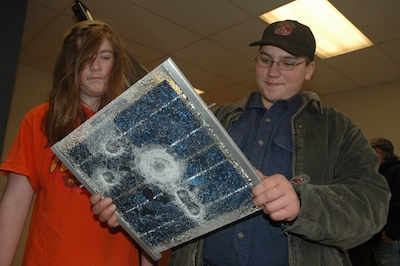MARYSVILLE — A Marysville solar panel manufacturer provided an education on solar energy to several Arlington-area students and their families, but their teacher is already aiming to use what they gained that day to educate the community beyond.
Stu Frothingham, who handles marketing and communications for Silicon Energy in Marysville, not only got to play tour guide through the company’s plant on Wednesday, Jan. 25, for Marci Bass’ students and their parents and guardians from the Stillaguamish Valley School in Arlington, but he also gave them a going-away present of a solar panel.
Bass had received a $500 Snohomish County Public Utility District mini-grant for public education to cover much of the cost of the panel, while Silicon Energy itself agreed to make up most of the remaining difference.
“These mini-grants cover a wide variety of topics, but we have a huge focus on renewable energy,” said Jenni Lamarca, public education programs coordinator for the Snohomish County PUD. “One of the things I noticed about Marci’s grant application is that she’s planning a solar fair around this solar panel, to educate the public beyond the classroom.”
Silicon Energy’s Marysville plant offered an education outside the classroom for visitors of all ages on Jan. 25, as kids and adults alike reacted with surprise when Frothingham explained to them that the Pacific Northwest is more well-suited than many people might think to solar energy.
“Heat is actually the enemy of solar panels, which work better when they’re cold,” Frothingham said.
“Solar panels are less efficient during the summer because there’s more resistance,” said Gary Shaver, president and CEO of Silicon Energy. “They even have to be designed to compensate for the fact that they over-perform in colder weather.”
“So why don’t you just make a cooler to cool them off?” asked David Bennett, a 13-year-old student at the Stillaguamish Valley School.
“Great question,” Frothingham said. “The problem then, though, becomes that you’re using energy drawn from the panels to cool the panels, rather than using it to power whatever you want to power in the first place. However, we have a built-in space between our two sets of panels that can be opened up to allow for cooling airflow.”
Bennett’s continued curious streak prompted Frothingham to estimate that Silicon Energy’s Marysville plant produces between 25-75 solar panels a day.
“Watching the machines at work was cool,” said Bennett, as he recalled seeing the delicate solar panel wafers being laid out in a grid and enclosed in what Frothingham compared to “a grilled-cheese sandwich of laminate layers on the inside and glass layers on the outside, the better to resist water and sand and other elements that could damage exposed wires in other types of solar panels.
“There’s so many processes involved in making a solar panel,” said Nate Ursino, 10, one of Bennett’s fellow students, and one of many to accidentally break the solar panel wafers that Frothingham gave them as another memento of their visit. “I didn’t realize how fragile this stuff was.”
At the same time that students learned firsthand how gently the ingredients of a solar panel need to be handled, they also got to test out the endurance of Silicon Energy’s finished product, when Frothingham encouraged Nate and his 12-year-old brother Kyle Ursino to jump repeatedly on a solar panel that’s withstood hundreds of such demonstrations already. Bennett and 12-year-old Liam Mayer also checked out a smaller solar panel that had withstood close-range gunfire without any of the bullets penetrating all the way through.
“Most solar panel manufacturers will say their panels are 80 percent good after 20 years,” Frothingham said. “Ours are still 80 percent good after 30 years. The National Renewable Energy Laboratory tested our solar panels and a bunch of other companies’ to see when they would fail, through simulated aging cycles of minus-40 and plus-80 degrees Celsius in high humidity, and after 80 simulated years, everyone else’s was done. After 100 simulated years, ours are still running like new.”
Just as Frothingham touted such solar panels as ideal for use by the military in hostile overseas environments where they might not have a reliable power source otherwise, so too did Lamarca describe solar energy as an emerging energy source of the future that the children of today would do well to be well-versed in.
“The next generation is going to need to be innovative,” Lamarca said.







